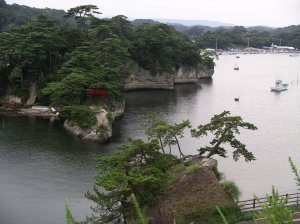Before the deluge
Setting the scene
The scene in the photo above is deceptively calm. A glass-smooth sea in a picturesque little inlet; beneath the surface of the pristine waters a trove of nori seaweed in cultivation. This is how the coast of Miyagi Prefecture near Sendai looked in September 2006. The photo was taken while I was on a bicycle trip that began in Sendai and ended 12 days later in Morioka, Iwate Prefecture.
I arrived in Sendai on the Shinkansen around noon of a sultry, late summer day, and immediately packed up the bike and headed eastward on the highway to find the storied Matsushima Islands. Located just off the coast and a little north of Sendai, this site is one of the top three scenic places in Japan.
It was an easy ride across a virtually flat terrain; even taking it slow with an overloaded bike, I arrived within a couple of hours. Though heavily commercialized with souvenir shops, numerous large and small boats plying the waters, and obnoxious megaphone-armed barkers out drumming up trade, it was still easy to see why the place has been the subject of so much awe, so many poems and songs. In a gently curving bay, numerous tiny islets rise vertically from the water. All are cloaked with lush undergrowth and crowned with weather-sculpted pines. Nestled in a dense grove atop one islet is Godaido, an ancient temple hall, with the quintessentially Japanese red bridge on its approach. Perhaps no one has summed up the sense of inarticulate admiration for the place better than Japan’s premier haikuist, Matsuo Bash0:
Matsushima ah!
A-ah, Matsushima, ah!
Matsushima, ah!
And then there was the nuclear power plant in Fukushima, the prefecture just south of Miyagi. Construction on the plant began in the 60‘s and it went into operation in 1971, amid a cacophony of assurances by TEPCO (Tokyo Electric Power Company) to local residents of its absolute safety. Yet, despite this region’s long history of 8+ magnitude earthquakes and catastrophic tsunami–a history readily available to even a casual researcher–this power plant’s safety mechanisms were built assuming a maximum 7+ magnitude quake and approximately 8 meter waves. As if those assumptions were not serious enough breaches of the public trust, the plant had a troubled history: there had been scandals and “incidents”; and TEPCO, aided by the blind eye turned to it by the ruling Liberal Democratic Party, was notorious for its culture of secrecy and obfuscation in its dealings with regulatory agencies and the public. By 2006, however, this was an aging plant, near its 40th anniversary, and there was a plan afoot to gradually decommission its six reactors. The decommissionings were already partially underway when the day of March 11, 2011 dawned.


I look forward to hearing about this attitude change you mention, Suzanne. I am very interested in all of your updates. Keep them coming! And I ask wonder f volunteers are really qualifies to do half of what they are being asked to do–sounds like good ol’ fashioned whitewashing to me. “Here, do this. Now it’s as good as new!” hmm, really? Bu given the state of the place, what it the alternative, really? がんぱって、ぬ!
Hi Cody,
Thanks again for comments. The attitude change here is real, in that there is–at last!–profound questioning of government bodies’ and agencies’ policies and pronouncements, particularly vis-a-vis the “safety” of nuclear power, but extending to all sorts of other policies and practices as well. Trouble is, life here is in disarray, beginning with mutiny in the Diet, fiscal problems that have been greatly magnified by the disaster, and so many people homeless, jobless, their future just a big question mark. As for the volunteers, of course we are all amateurs, but at least in Ishinomaki the directors of PeaceBoat have been well trained in safety practices, and are now working directly with the community. At first they received all their job assignments from the local social welfare office, but recently they were given autonomy within their immediate neighbourhoods, and have begun soliciting requests directly from the local residents. Some days we really wondered if what we were doing had any point, but we were reminded that these requests had been submitted by the people of the neighbourhood. And keep in mind, these neighbourhoods are utterly decimated, so anything we can do to help a families return to their houses where they can start putting the pieces of their lives back together, is worthwhile. My later posts have a couple of notable “success stories.”
My apologies for being so slow in posting. Transmission and reception of cell phone signals was spotty at best up there, so I didn’t dare try to post by email, as I had thought I would. I also wanted to edit a little and add pix. The pix are giving me headaches–they won’t stay where I put them!–so it is taking more time than I want. I should have the rest of the pages up by the weekend. Keep the comments coming! 🙂
A good start, Suz’! I also remember Matsushima’s loveliness and am filled with sadness for our friends, the Japanese. That said, I am also very, very proud of them. Have you see Rex Murphy’s piece on their resilience and tenacity? LINK: http://www.cbc.ca/thenational/indepthanalysis/rexmurphy/story/2011/03/17/thenational-rexmurphy-110317.html
Hey Cody, thanks for the encouragement of my fledgling blog. .:-) I checked your link and indeed, everything he says is true–in spades. If any country can pull through such a concatenation of disasters, it is the Japanese. There is something new afoot here, too, an attitudinal change that I will write about in the coming days.